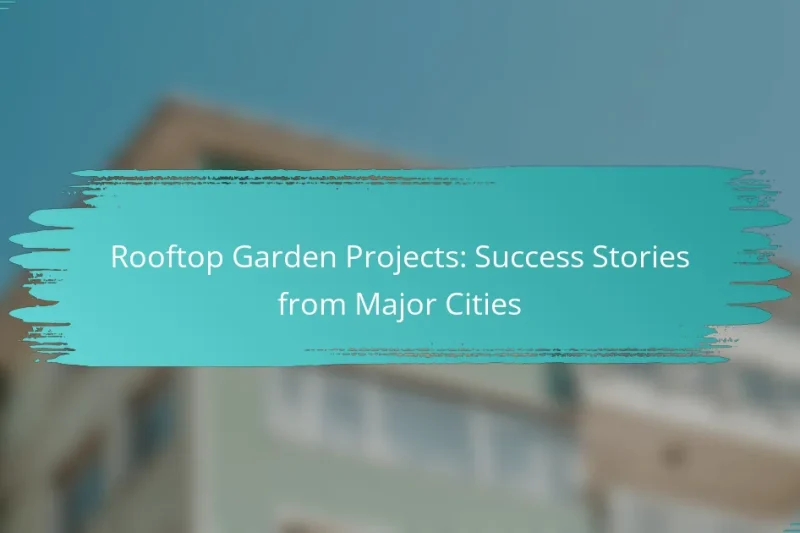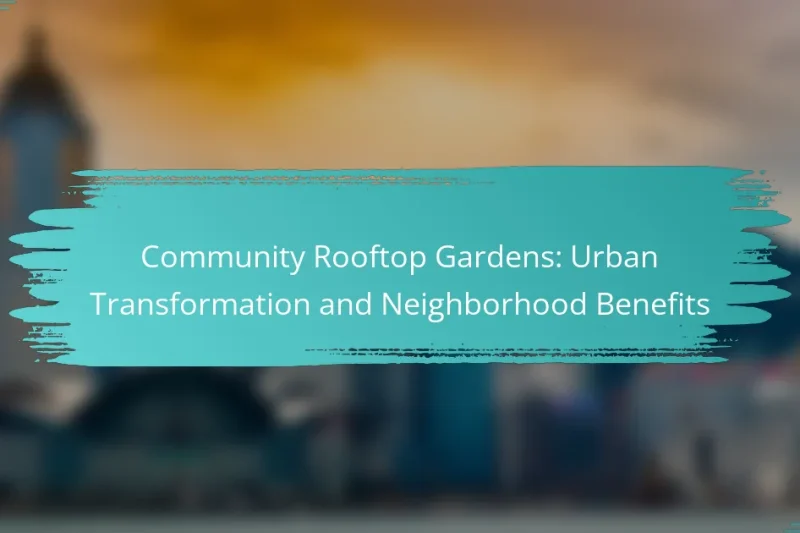Rooftop garden projects in major cities like New York City showcase innovative approaches to utilizing urban … Rooftop Garden Projects: Success Stories from Major CitiesRead more
Rooftop Garden Case Studies
Rooftop gardens are transforming urban landscapes, particularly in cities like New York, by utilizing underused spaces to promote sustainability and community interaction. These green roofs not only enhance biodiversity and air quality but also provide vital areas for food production and ecological balance. Through thoughtful design and effective management, rooftop gardens can thrive in densely populated areas, offering numerous benefits to both residents and local wildlife.
Rooftop Garden Designs: Innovations from Leading Landscape Architects
Rooftop garden designs from leading landscape architects are transforming urban environments by maximizing green space and … Rooftop Garden Designs: Innovations from Leading Landscape ArchitectsRead more
Community Rooftop Gardens: Urban Transformation and Neighborhood Benefits
Community rooftop gardens are pivotal in transforming urban landscapes by introducing green spaces that significantly improve … Community Rooftop Gardens: Urban Transformation and Neighborhood BenefitsRead more
What are successful rooftop garden case studies in New York City?
Successful rooftop garden case studies in New York City demonstrate innovative uses of urban space, enhancing sustainability and community engagement. These projects showcase how green roofs can contribute to food production, biodiversity, and improved air quality in a densely populated environment.
Brooklyn Grange Rooftop Farm
Brooklyn Grange operates one of the largest rooftop farms in the world, spanning over two acres across multiple rooftops in Brooklyn. This urban farm focuses on organic farming practices, producing a variety of vegetables and herbs for local restaurants and markets.
Key considerations for similar projects include selecting appropriate crops that thrive in rooftop conditions and implementing efficient irrigation systems. The farm also hosts educational programs and events, fostering community involvement and awareness about urban agriculture.
One World Trade Center Green Roof
The green roof at One World Trade Center features a landscaped terrace that enhances the building’s sustainability profile while providing stunning views of the city. This green space is designed to support local flora and fauna, contributing to urban biodiversity.
When planning a green roof, consider structural load requirements and the selection of native plants that require minimal maintenance. The roof also incorporates rainwater harvesting systems, which can reduce runoff and improve water management in the area.
High Line Park Rooftop Gardens
The High Line Park includes several rooftop gardens that complement the elevated linear park’s design, providing green spaces for visitors and enhancing the urban landscape. These gardens feature a mix of native and ornamental plants, creating habitats for wildlife and improving air quality.
For effective rooftop garden design, prioritize accessibility and aesthetic appeal while ensuring proper drainage and soil depth. Engaging local artists for unique installations can also enhance the garden’s cultural significance and attract more visitors.
How do rooftop gardens improve urban environments?
Rooftop gardens enhance urban environments by providing green spaces that contribute to ecological balance, reduce temperatures, and improve air quality. These gardens serve as multifunctional areas that benefit both residents and local wildlife.
Enhancing biodiversity
Rooftop gardens create habitats for various species, including birds, insects, and plants, which may otherwise struggle to survive in urban settings. By incorporating native plants, these gardens can attract pollinators and support local ecosystems.
Designing a rooftop garden with diverse plant species increases the chances of attracting different wildlife. Consider including flowering plants, shrubs, and small trees to maximize biodiversity.
Reducing urban heat island effect
Rooftop gardens help mitigate the urban heat island effect by providing insulation and cooling through evapotranspiration. This process can lower rooftop temperatures significantly compared to traditional surfaces, which absorb and retain heat.
In cities, the temperature difference can be substantial, with rooftop gardens potentially reducing surface temperatures by several degrees. This cooling effect can lead to lower energy costs for air conditioning and improved comfort for residents.
Improving air quality
Rooftop gardens contribute to better air quality by filtering pollutants and absorbing carbon dioxide. Plants naturally take in harmful gases and release oxygen, creating a healthier atmosphere for urban dwellers.
Implementing a rooftop garden can reduce particulate matter and other airborne toxins, benefiting both human health and the environment. Regular maintenance, such as watering and plant care, ensures the garden remains effective in purifying the air.
What are the key design elements of effective rooftop gardens?
Effective rooftop gardens incorporate several essential design elements, including appropriate plant selection, efficient water management systems, and careful structural considerations. These components work together to create a sustainable and functional green space that can thrive in an urban environment.
Plant selection
Choosing the right plants is crucial for the success of a rooftop garden. Opt for species that are drought-resistant and can tolerate wind and varying sunlight conditions, such as succulents, native grasses, and herbs. Consider the local climate and select plants that will thrive in your specific environment.
Grouping plants with similar water and light needs can simplify maintenance and enhance the overall aesthetic. For instance, combining flowering plants with greenery can create visual interest while ensuring that all plants receive the care they require.
Water management systems
Effective water management is vital for rooftop gardens to prevent overwatering and ensure healthy plant growth. Implementing a drip irrigation system can provide consistent moisture while minimizing water waste. Rainwater harvesting systems can also be beneficial, allowing you to collect and reuse rainwater for irrigation.
Consider incorporating moisture sensors to monitor soil conditions and automate watering schedules. This can help maintain optimal moisture levels, especially during dry spells, and reduce the risk of plant stress or disease.
Structural considerations
Before installing a rooftop garden, it’s essential to assess the structural integrity of the building. Ensure that the roof can support the additional weight of soil, plants, and water. Consulting with a structural engineer can help determine load limits and necessary reinforcements.
Additionally, consider the drainage system to prevent water accumulation, which can lead to leaks or structural damage. Proper drainage solutions, such as perforated trays or gravel layers, can facilitate water flow and protect the building’s integrity.
What are the costs associated with installing a rooftop garden?
The costs of installing a rooftop garden can vary significantly based on factors like size, design, and materials. Generally, you should consider both initial setup costs and ongoing maintenance expenses, along with potential financial incentives that can offset these costs.
Initial setup costs
Initial setup costs for a rooftop garden typically range from a few thousand to tens of thousands of dollars, depending on the complexity of the design and the materials used. Key expenses include structural assessments, waterproofing, soil, plants, irrigation systems, and labor. For instance, a simple garden may cost around $5,000, while a more elaborate setup could exceed $20,000.
It’s crucial to conduct a thorough site analysis before installation, as this can reveal additional costs related to structural reinforcements or drainage systems. Always obtain multiple quotes from contractors to ensure competitive pricing.
Maintenance expenses
Maintenance expenses for rooftop gardens can vary widely, generally falling between $500 and $2,000 annually. Regular tasks include watering, fertilizing, weeding, and seasonal plant replacement. The level of maintenance required will depend on the types of plants chosen and the garden’s overall design.
Consider hiring a professional service for maintenance if you lack the time or expertise. This can ensure the garden remains healthy and vibrant, but it will add to your overall costs.
Potential financial incentives
Many local governments and organizations offer financial incentives for installing rooftop gardens, which can significantly reduce overall costs. These incentives may include tax credits, grants, or rebates aimed at promoting green infrastructure and sustainability.
Research available programs in your area, as they can vary widely. For example, some cities may offer up to 50% off installation costs through specific environmental initiatives. Always check eligibility requirements and application processes to maximize your savings.
What are the challenges of maintaining rooftop gardens?
Maintaining rooftop gardens presents several challenges, including access and safety concerns, weather-related issues, and pest management. Each of these factors requires careful consideration to ensure the garden thrives and remains safe for users.
Access and safety concerns
Access to rooftop gardens can be limited, making it difficult to transport materials and perform maintenance. Proper safety measures, such as guardrails and non-slip surfaces, are essential to prevent accidents.
Additionally, ensuring that all users can safely access the garden is crucial. This may involve installing elevators or staircases that comply with local building codes, especially in urban areas where rooftop gardens are common.
Weather-related issues
Rooftop gardens are exposed to varying weather conditions, which can impact plant health and maintenance. High winds, intense sunlight, and heavy rainfall can all pose risks, necessitating the selection of resilient plant species that can withstand these elements.
Implementing proper drainage systems is vital to prevent water accumulation, which can lead to root rot and other issues. Regularly monitoring weather forecasts can help gardeners prepare for extreme conditions and take preventive measures.
Pest management
Pest management in rooftop gardens can be challenging due to the limited space and potential for rapid pest proliferation. Regular inspections are necessary to identify and address pest issues before they escalate.
Utilizing integrated pest management (IPM) strategies can be effective. This includes introducing beneficial insects, using organic pesticides, and maintaining plant diversity to reduce the likelihood of infestations. Keeping the garden clean and removing debris can also deter pests.
How can businesses benefit from rooftop gardens?
Businesses can benefit from rooftop gardens by enhancing employee well-being, improving brand image, and contributing to sustainability efforts. These gardens provide green spaces that promote relaxation and can lead to increased productivity while also showcasing a commitment to environmental responsibility.
Employee wellness and productivity
Rooftop gardens create a serene environment that can significantly boost employee wellness. Access to green spaces has been linked to reduced stress levels and improved mental health, which can enhance overall job satisfaction.
Incorporating areas for relaxation, such as seating or walking paths, encourages employees to take breaks, leading to higher productivity. Companies may notice a decrease in absenteeism and an increase in creativity when employees have a space to recharge.
Brand image enhancement
Having a rooftop garden can elevate a company’s brand image by demonstrating a commitment to sustainability and corporate social responsibility. This visual representation of green initiatives can attract environmentally conscious customers and clients.
Moreover, businesses can leverage their rooftop gardens in marketing campaigns, showcasing their efforts to create a healthier environment. This can differentiate them from competitors and foster loyalty among consumers who value eco-friendly practices.


